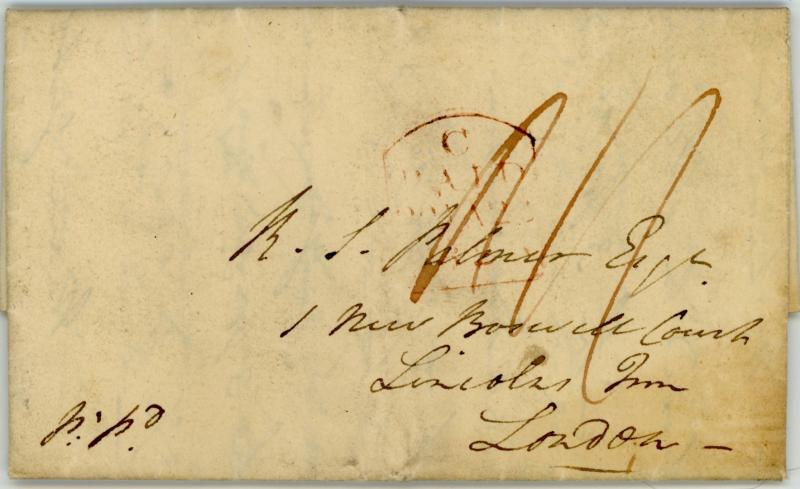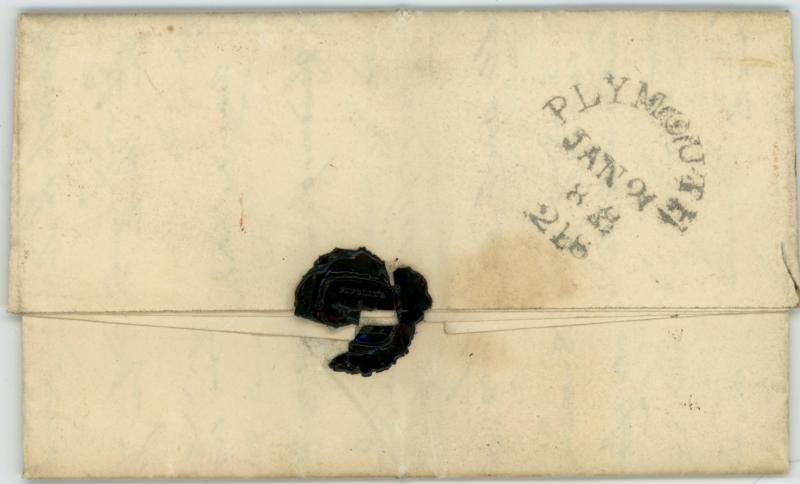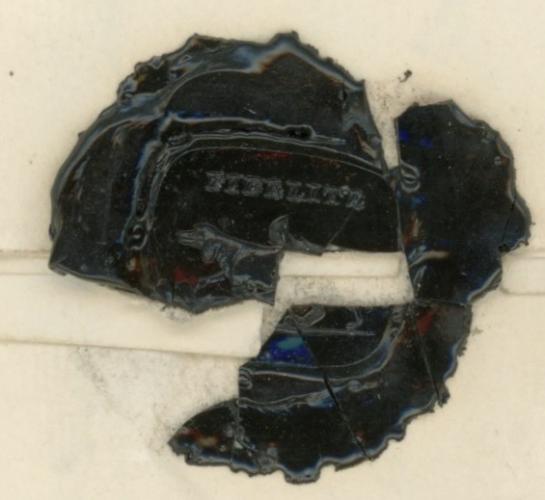05-08-2025, 11:23 AM
Great Britain has a fascinating philatelic history since the introduction of the adhesive stamp in 1840. The period before this reform is equally fascinating.
Here's a prepaid cover from Plymouth to London in the winter of 1828.
It was sent to R[obert] S[amuel] Palmer, Esq., 1 New Boswell Court, Lincoln's Inn, London. Robert S. Palmer (1800-1891) was a barrister, originally from Devon, who had chambers on a short cul-de-sac against the west wall of Lincoln's Inn.
On the front of the cover there is a manuscript 11 in red ink. This would indicate that the postal rate of 11d from Plymouth to London was paid in advance. This is confirmed by the handwritten p.p'd' [Postage Paid], written in the lower left corner as well as the red single line tombstone postmark marked C / PAID / 20 JA 28 / [1]828. The C in the postmark would be the sorting desk. The single line indicates that it was applied in the morning. [Whitney, 1/32]
The tombstone postmark has a 'pen cancel'. I wonder if this could be considered an early security measure to ensure that the paid tombstone could not be reused?
The inland rate, at the time, for a single sheet letter travelling 170-230 miles was 11d.

On the back of the cover, there is a postmark from Plymouth in black ink - in an arc PLYMOUTH with JAN 21 / [1]8[2]8 / 218. 218 would be the mile marker between Plymouth and London. Again, confirming the postage as 11d.

There is a remnant of a black, wax seal. The word FIDELITY (mirror reversed on the seal itself) is at the top of the impression. Underneath there is a slim, long-tailed hound a common sigil at that time.

The cover is constructed from a single sheet of folded wove paper 37x23cm (Imperial Post Quarto). Using a light-table a watermark is visible reading B.E.& S., BATH, 1825. This would be the De Montalt Mill, Combe Down, Bath. It was owned by John Bally, William Ellen and George Steart. The artist Joseph Mallord William Turner was known to favour their paper. The firm specialized in fine writing and artists' paper.

The inside sheet contains two letters ... both written on the same day, January 20, 1828, at 1 George Place, Plymouth by Thomas and Mary Colby. The first (2 pages) is a friendly covering note to Robert Palmer. The second is a more formal (1 page) letter providing instruction to their two trustees Palmer and Charles William Johnson (in connection with the estate of a relative (which probably explains the black wax). This second letter The shorter, tells their trustees to “sell out the stock belonging to us in the 3 percent Consols and invest the same in the 3½ percent Reduced.”
Why? In 1827 the Treasury converted part of the National Debt into a new 3½% bond issue. Investors could exchange their low-yield 3% Consols (a perpetual, no-maturity, government bond created in 1751 when Parliament consolidated war debts into a single 'stock'. It paid a fixed 3% interest payment every six months) for the new, higher-paying 3½% at par, improving income without touching capital. The Colbys are simply asking Palmer and Johnson to execute that government-backed swap. The stock itself was just an entry on the Bank of England’s ledger. Ownership was transferred by a clerk writing your name in the ledger book. This was the job that Palmer & Johnson were being asked to do for the Colby's. ['Consols' meant Consolidated Annuities]
A nice little pre-paid cover dealing with the housekeeping of a Regency era trust fund. In short, the government got cheaper debt in the long run while investors enjoyed an immediate boost in income.
That's one of the reasons I like postal history. It's a fossil record of the grand sweep of history and how it affected the daily lives of the people who lived through it.
Here's a prepaid cover from Plymouth to London in the winter of 1828.
It was sent to R[obert] S[amuel] Palmer, Esq., 1 New Boswell Court, Lincoln's Inn, London. Robert S. Palmer (1800-1891) was a barrister, originally from Devon, who had chambers on a short cul-de-sac against the west wall of Lincoln's Inn.
On the front of the cover there is a manuscript 11 in red ink. This would indicate that the postal rate of 11d from Plymouth to London was paid in advance. This is confirmed by the handwritten p.p'd' [Postage Paid], written in the lower left corner as well as the red single line tombstone postmark marked C / PAID / 20 JA 28 / [1]828. The C in the postmark would be the sorting desk. The single line indicates that it was applied in the morning. [Whitney, 1/32]
The tombstone postmark has a 'pen cancel'. I wonder if this could be considered an early security measure to ensure that the paid tombstone could not be reused?
The inland rate, at the time, for a single sheet letter travelling 170-230 miles was 11d.
On the back of the cover, there is a postmark from Plymouth in black ink - in an arc PLYMOUTH with JAN 21 / [1]8[2]8 / 218. 218 would be the mile marker between Plymouth and London. Again, confirming the postage as 11d.
There is a remnant of a black, wax seal. The word FIDELITY (mirror reversed on the seal itself) is at the top of the impression. Underneath there is a slim, long-tailed hound a common sigil at that time.
The cover is constructed from a single sheet of folded wove paper 37x23cm (Imperial Post Quarto). Using a light-table a watermark is visible reading B.E.& S., BATH, 1825. This would be the De Montalt Mill, Combe Down, Bath. It was owned by John Bally, William Ellen and George Steart. The artist Joseph Mallord William Turner was known to favour their paper. The firm specialized in fine writing and artists' paper.
The inside sheet contains two letters ... both written on the same day, January 20, 1828, at 1 George Place, Plymouth by Thomas and Mary Colby. The first (2 pages) is a friendly covering note to Robert Palmer. The second is a more formal (1 page) letter providing instruction to their two trustees Palmer and Charles William Johnson (in connection with the estate of a relative (which probably explains the black wax). This second letter The shorter, tells their trustees to “sell out the stock belonging to us in the 3 percent Consols and invest the same in the 3½ percent Reduced.”
Why? In 1827 the Treasury converted part of the National Debt into a new 3½% bond issue. Investors could exchange their low-yield 3% Consols (a perpetual, no-maturity, government bond created in 1751 when Parliament consolidated war debts into a single 'stock'. It paid a fixed 3% interest payment every six months) for the new, higher-paying 3½% at par, improving income without touching capital. The Colbys are simply asking Palmer and Johnson to execute that government-backed swap. The stock itself was just an entry on the Bank of England’s ledger. Ownership was transferred by a clerk writing your name in the ledger book. This was the job that Palmer & Johnson were being asked to do for the Colby's. ['Consols' meant Consolidated Annuities]
A nice little pre-paid cover dealing with the housekeeping of a Regency era trust fund. In short, the government got cheaper debt in the long run while investors enjoyed an immediate boost in income.
That's one of the reasons I like postal history. It's a fossil record of the grand sweep of history and how it affected the daily lives of the people who lived through it.
Hugh MacDonald, Wolfe Island
Member: BNAPS. PHSC, Auxiliary Markings Club, Postal Stationary Society, British Postmark Society,
AMG Collectors Club, China Stamp Society, France and Colonies Philatelic Society
ArGe Deutsche Feldpost: 1914-1918 e.V.

